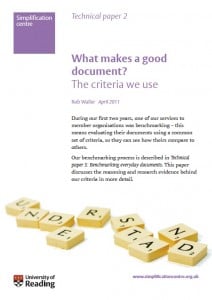Last year I did a post on ‘The importance of textual design‘, which included discussion of Rob Waller’s excellent site devoted to the topic. I recently went back to Rob’s site to see some of his latest posts.
The first to catch my eye was on legibility, wherein he discussed his project which revealed that a narrower typeface can decrease legibility. Not only that, it appeared that “a smaller size of a regular font was just as legible as a narrow one at the same size – so using a condensed font to fit in longer names is actually unnecessary”. It’s an interesting read, especially as he dissects a piece of research which appears to contradict his findings. And take the time to look around his web site: a favourite topic is inappropriate signs, and he’s found some hilarious examples.
 While browsing Rob’s site, I checked his recent publications and came across a beauty, which brings us to the point of the title of this post: making a good document. The paper, ‘What Makes a Good Document?: The Criteria We Use‘, discusses the guidelines and criteria which govern the benchmarking process used by The Simplification Centre.
While browsing Rob’s site, I checked his recent publications and came across a beauty, which brings us to the point of the title of this post: making a good document. The paper, ‘What Makes a Good Document?: The Criteria We Use‘, discusses the guidelines and criteria which govern the benchmarking process used by The Simplification Centre.
If you take the time to read it (and you should, it’s only 35 pages, including references), then you’ll find consideration of the concepts of cognitive capacity, strategic reading, affordance and schemata, along with detailed discussion of each criterion. But just in case you simply want to see the criteria, then the following useful table summarises them:
[embeddoc url=”https://opob.edublogs.org/files/2015/10/Criteria-for-good-document-ymefeo.pdf” viewer=”google”]
All good sensible stuff, I’m sure you’ll agree: useful for trainers, organisations and individuals seeking to improve their written communication skills.